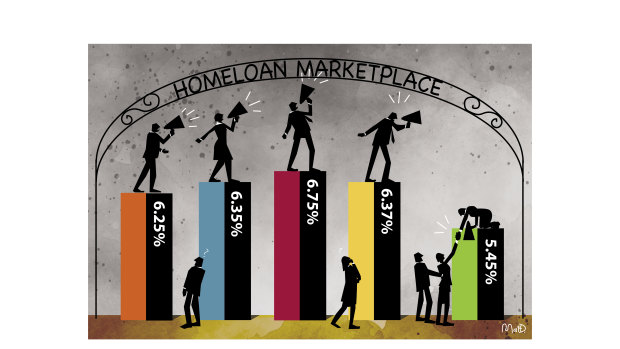[ad_1]
Lately, however, banks have been forced to not only compete for new business, but also to work harder to retain existing borrowers, many of whom have come off expiring fixed-rate loans. Bankers insist it’s the most competitive market they’ve seen.
So, what’s changed that sparked this bout of competition?

Stiff competition for mortgages has taken a bite out of the banks’ profits.Credit: Matt Davidson
Banking in Australia is generally seen as an oligopoly – a market dominated by a few giants, who are happy to steer clear of aggressive price competition, instead focusing on marketing and other ways of differentiating themselves.
But this view is being challenged by some banks being prepared to stomach sharp declines in their net interest margins (NIMs) – a gauge of profitability that compares funding costs with what banks charge for loans.
ANZ, the fourth-biggest home lender, this week spooked investors when it reported its margin collapsed from 2.39 per cent to 2.06 per cent in the six months to September, as the bank tried to grow by offering sharper deals. Westpac’s consumer bank, which has also been in expansion mode, reported a 24 basis point contraction in its NIM.
The main reasons for these falls are fierce competition for both loans and deposits, which means profits are being squeezed on two fronts.
NAB and Commonwealth Bank are taking a different approach: they are happy to lose a bit of market share in mortgages because they think some of the more aggressing pricing from rivals is unsustainable. But their margins are also falling and there’s a debate about how long they can sit on the sidelines.
Investors are convinced the glory days of retail banking are in the past, and a key reason for this is because consumers are getting better at chasing competitive deals.
Will the banks eventually go back to the more cosy arrangement that allowed everyone to make higher returns from mortgages? Many bankers certainly hope so, but others doubt it.
The optimistic bankers hope that once the many ultra-cheap fixed-rate loans that were issued during the pandemic have expired, there will be fewer borrowers hunting around for sharper interest rates. There’s also a theory that ANZ is competing hard to support its case that it should be able to buy Suncorp’s bank.
Now, it’s certainly possible competition weakens if ANZ and Westpac decide they can’t bear any more margin pain, and they ease up on the discounts they are offering.
However, some highly regarded bank analysts think the outbreak of competition in mortgages is more than a blip. Instead, they think it reflects deep-seated shifts in how people get loans, and the power big banks have to set prices.
In particular, they point to the growing role of mortgage brokers, who present customers with competing offers from various banks. Brokers have been on the rise for many years, and they now arrange about 70 per cent of all new home loans.
The banking royal commission of 2018 didn’t like the fact brokers get paid by commission, but on balance they have added to competition by encouraging customers to hunt around for sharper interest rates. Brokers – as well as comparison websites – also make it much easier for people to know if they’re getting a decent interest rate compared to what rivals are offering.
In financial jargon, they’ve contributed to home loans becoming commodities – products that are basically interchangeable from one bank to the next.
Businesses want to avoid their products becoming “commoditised” because it means they can’t charge as much, but the trend is good for customers, and it also makes financial sense.
Home loans have historically been a very low risk for banks (lower risk than lending to businesses), and it’s hard to see why mortgages should drive jumbo returns for banks.
Loading
Jefferies analyst Matt Wilson, for instance, has estimated the return on equity from a home loan was until fairly recently about 30 per cent thanks to the banking oligopoly, but in theory, it could fall to about 12 per cent if risk were priced correctly. Barrenjoey’s Jonathan Mott this week estimated ANZ’s retail bank return on equity had fallen from about 30 per cent to 12.7 per cent, and he forecast it had further to drop.
Despite the banks’ record profits, investors are convinced the glory days of retail banking are in the past, and a key reason for this is because consumers are getting better at chasing competitive deals.
Ross Gittins is on leave.
The Market Recap newsletter is a wrap of the day’s trading. Get it each weekday afternoon.
[ad_2]
Source link


